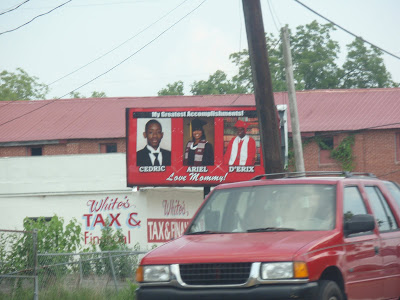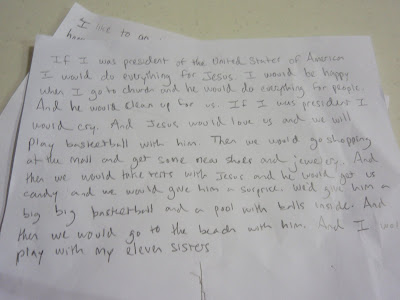It was too far and unsafe for the young people living across Highway 45 in Prichard to make it to the Head Start testing site, so we had to administer in-home surveys to them. We had difficulty finding previous participants because the population is so transient and so many families are moving out of Prichard. Sometimes they had never heard of the family or child, which usually meant that the kid used a fake address and/or name to take the survey multiple times. Sometimes houses were completely boarded up or were vacant with broken windows. Some addresses were simply no where to be found.
We finally found a family with a 10 and 11 year old that had time to take the survey. The house was very old and run down. Paint flakes littered the dirt around the house, exposing large areas of rotted wood on the house. The house was also on brick stilts, elevating the house about a foot from the ground. A porch with a grill and rocking chair extended about three feet from the weathered door. Heaps of tires and empty lighter fluid containers were in corners of the yard, which was all dirt except for some straggly bushes around the absent house foundation. The 11 year old daughter told us that the people on the list no longer lived in the house but that she and her sister were old enough to take the survey. She disappeared into the house yelling for her mama to come out and sign the consent papers. A very heavy set woman came to the door fanning herself with a rag. She told us to come in out of the sun to talk to her.
The house was very dark with bright green living room furniture that was awkwardly angled because it was too large for the space. A pink TV rested on a stack of books across the living room and every inch of walls was covered in family photos. A giant wood table was at the other end of the room near the door to the kitchen, again too big for the tiny space. A strange assortment of dressers lined all the walls and a small bathroom and two bedrooms were off the large living/dining room to the left. For a mother and two daughters, it was tight but seemed comfortable enough. However, we found-out later the woman's fiance and some of his kids sometimes lived there, so it was extremely crowded and there were not enough beds for everyone. While the furniture appeared to be from the 1970s, it was in relatively good condition but the walls, carpet and floor tiling was in horrible condition. There were also dead flies and roaches speckling the floors. A giant blanket was nailed across the top of the kitchen door to try and keep the oven and deep-frier heat from escaping into the rest of the house. I got a small glimpse of the kitchen, which was also very run down. An old laundry sink held the deep-frier, and dirty dishes were piled on every service.
Jayrrd began reading the survey to the two girls and my job was to distract mom from listening to some of the sensitive questions about alcohol and drug use, neighborhood violence and sexual behavior. Our conversation began as small talk. I learned about when they had moved in, what she cooked for the family, she teased me about sweating so much, and she told me about her fiance and his children. I learned through the conversation that she had just moved back to Mobile (we were actually technically in Mobile and the next block over was Prichard) to be closer to her mother and to get her daughters out of the fast-paced life of Orlando, Florida. It was interesting that she referred to Mobile as country. This has been a common theme, which was explained to me more as a culture, rather then a physical rural location. The slower paced and more isolated feel of this neighborhood in Mobile mixed with the deep South culture was defined as "country". Some of the interns who grew-up in Georgia and Alabama also refer to the kids as "country".
She explained that she liked the country life of Mobile because it was safer for her babies. She said her 11 year-old daughter had friends that were already pregnant and stripping in Orlando, and young girls were constantly targeted by pimps and men that wanted to exploit them. She said her baby developed very young and that she was afraid she would be rapped or wind-up pregnant. Two things struck me as interesting from her story. First, that this Mobile neighborhood has more concentrated poverty and a very high rate of unintended adolescent pregnancy. While it sounded like her Orlando neighborhood was a dangerous place... this neighborhood was probably just as dangerous. But it was home to her and she felt safer raising her girls in what she termed as "slow movin', country livin'". The second thing that struck me was her mentioning that her daughter "developed" early and because of this, she would be targeted by men that wanted to sexually exploit her. This was very difficult to hear for me, and unfortunately, a reality for many of these young girls. I was also surprised how openly she discussed her daughter hitting puberty with me. No parent I have ever talked to has casually mentioned their child's early puberty to me in any context.
I decided it was appropriate to ask her more personal questions about her daughter because she seemed to offer information about her hitting puberty so freely. I asked her if she had talked to her daughter about sex yet, especially after her friends got pregnant. She laughed and said "Honey, they ain't a day go by that I don't talk to my girls about sex". Again, a statement that completely upset my preconception of low income parents not discussing sex with their kids. I realized that my sex ed training in parent involvement pertains to middle and upper class folks, and lack of parent involvement in sex education may not be as persistent of a problem in low income communities in which adolescent pregnancy has become normalized and is very prevalent. Here was a mother that did not finish high school that realized her daughter's friends were having sex and getting pregnant, and actively initiated having conversations about sex with her 11 year old daughter. I saw this as an example of model parenting. When I asked her if she thought other mother's talked about sex with their children, she laughed and said that all Mama's don't want their babies making the same mistakes they made by having kids too young, so they need to talk to their daughters.
She did not say anything about boys... in her mind, boys were the problem and the burden of teen pregnancy was on the daughter and her family. "The little boys just run home to their mamas and we're [the mother's of the daughters that get pregnant] are left with another mouth to feed". This statement upset the misconception that young women become pregnant from older men. On the survey and through talking with people in the neighborhoods, most girls are getting pregnant from boys about their age or younger. There is about a 4 to 1 ratio of women to men in the neighborhoods, so many young boys have older sexual partners.
I was very disheartened by how she villanized boys but I understood why she did because in most cases, the father is uninvolved or does not have the resources to be an involved parent. She constantly said that little boys are running around getting girls pregnant and spreading diseases, and that she had to protect her daughters from them. One way she protected her girls from unwanted advances from boys was by telling them how beautiful they were everyday. She said that if she told them they were beautiful everyday, then when boys complemented them, they could say, "I know I am, my mama tells me everyday" and they would not have sex because they had poor self-esteem and liked the boys positive attention. The rigid gender norms of a dichotomous hyper-masculine, predatory male and weak female that needs to be protected, was how she conceptualized heterosexual relationships. While her sex education talks with her daughters were very sex-negative, at least she was talking to them about sex and pregnancy. Again, she used a lot of scare tactics by villanizing boys and there was no talk about preventing STIs and unintended pregnancy. But she was not naive about how young children initiated sex in the neighborhood.
We ended the conversation with her saying, "I just want my daughters to do better than me... to graduate school and make something of themselves." This is every good parent's dream for their children. I learned so much from this mother about parent involvement in informal sex education with their children. One of the most profound things she taught me was that teen pregnancy has not been normalized to the point where parents are fine with their children having babies, which is a common misconception. However, it is a reality of life in these neighborhoods and more than an open parent dialogue is needed to prevent children as young as 10 and 11 from having babies.











































